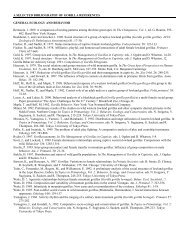First Prosimian Husbandry Workshop 2009 - Cleveland Metroparks ...
First Prosimian Husbandry Workshop 2009 - Cleveland Metroparks ...
First Prosimian Husbandry Workshop 2009 - Cleveland Metroparks ...
You also want an ePaper? Increase the reach of your titles
YUMPU automatically turns print PDFs into web optimized ePapers that Google loves.
Session 2: <strong>Prosimian</strong> Health<br />
(Moderator Cathy Williams, DVM Duke Lemur Center)<br />
Topics<br />
• Intro to session<br />
• Exams and diagnostic testing<br />
• Species specific disease problems<br />
• Common health problems in captivity (dental problems, diarrhea/gastro intestinal, obesity,<br />
diabetes, infections, kidney disease, cancer, other)<br />
Cancer:<br />
The better diets we provide and the better we are at husbandry, the more cancer we will get. Animals<br />
die eventually and cancer is often an old-age disease. A study was just done examining medical<br />
records and the types of cancer observed. They found 123 cases of cancer in 101 animals. The<br />
digestive system was affected the most with the liver being the most affected organ. This was<br />
followed by hematopoietic, endocrine, reproductive, urinary, skin, respiratory and nervous systems in<br />
that order. We do not find many mammary tumors, but other reproductive organs can be affected. The<br />
most common tumor in the liver is a hepatocellular carcinoma. Humans that experience iron overload<br />
are more likely to develop liver tumors. They found no relationship in lemurs. Also, found no<br />
hepatitis viruses. Age 11 to 15 is the most common age at death.<br />
Question (Grace Fuller): Is there a relationship between light cycle and development of mammary<br />
tumors?<br />
Moderator (Cathy Williams): Higher estrogen levels stimulate breast cancer. Blind people have a<br />
lower incidence of breast cancer and the more light they see the higher their risk. People with breast<br />
cancer have lower melatonin levels. In animals, melatonin has an anti-estrogen effect. Melatonin-like<br />
compounds may be a treatment for women with breast cancer. We do not know if lemurs housed in<br />
environments housed in high light intensity at higher risk for developing cancer. Its better to provide a<br />
more natural light spectrum.<br />
Diabetes:<br />
Type 1-juvenile diabetes, deals with an immune response, early-onset and inherited.<br />
Type 2-used to be considered old-age onset, more closely related to diet and food intake, occurs more<br />
in obese people.<br />
We most likely see Type 2 diabetes in our animals and can be controlled with proper diet. If an animal<br />
has untreated diabetes, blood sugar is very high. If they have too much insulin, blood glucose can be<br />
very low. Average blood glucose is about 100. Lemurs are very prone to developing stress<br />
hyperglycemia…this does not mean they are diabetic, but that they are stressed or scared. If the blood<br />
sits too long, you may get lower values.<br />
Question (Dawn Stone) How long does it take for increases in glucose from stress from catch-up to go<br />
down?<br />
Moderator (Cathy Williams): This is not known.<br />
Case study: Female brown lemur..her glucose came back at 400 ug/dL (very high). There was also<br />
sugar in the urine. Once blood sugars get over 300, sugar starts spilling over into urine. You can also<br />
test serum fructosamine, which tells what glucose has been over the long term. This female was 289<br />
and normal is 450, so she was not diabetic. Lesson learned: never believe one set of tests ever, need to<br />
take multiple tests.<br />
15




